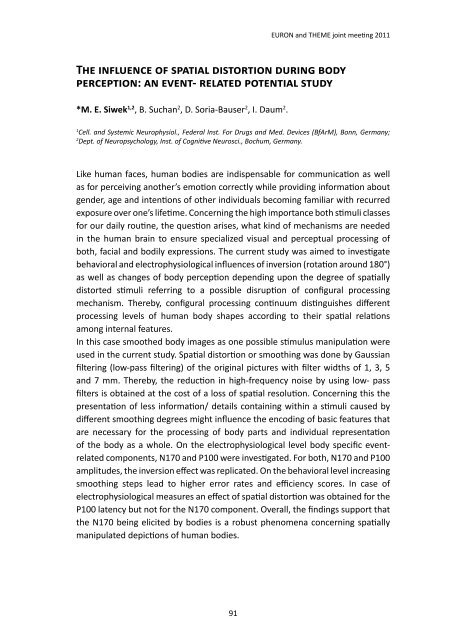EURON and THEME joint PhD meeting
EURON and THEME joint PhD meeting
EURON and THEME joint PhD meeting
You also want an ePaper? Increase the reach of your titles
YUMPU automatically turns print PDFs into web optimized ePapers that Google loves.
91<br />
<strong>EURON</strong> <strong>and</strong> <strong>THEME</strong> <strong>joint</strong> <strong>meeting</strong> 2011<br />
The influence of spatial distortion during body<br />
perception: an event- related potential study<br />
*M. E. Siwek 1,2 , B. Suchan 2 , D. Soria-Bauser 2 , I. Daum 2 .<br />
1 Cell. <strong>and</strong> Systemic Neurophysiol., Federal Inst. For Drugs <strong>and</strong> Med. Devices (BfArM), Bonn, Germany;<br />
2 Dept. of Neuropsychology, Inst. of Cognitive Neurosci., Bochum, Germany.<br />
Like human faces, human bodies are indispensable for communication as well<br />
as for perceiving another’s emotion correctly while providing information about<br />
gender, age <strong>and</strong> intentions of other individuals becoming familiar with recurred<br />
exposure over one’s lifetime. Concerning the high importance both stimuli classes<br />
for our daily routine, the question arises, what kind of mechanisms are needed<br />
in the human brain to ensure specialized visual <strong>and</strong> perceptual processing of<br />
both, facial <strong>and</strong> bodily expressions. The current study was aimed to investigate<br />
behavioral <strong>and</strong> electrophysiological influences of inversion (rotation around 180°)<br />
as well as changes of body perception depending upon the degree of spatially<br />
distorted stimuli referring to a possible disruption of configural processing<br />
mechanism. Thereby, configural processing continuum distinguishes different<br />
processing levels of human body shapes according to their spatial relations<br />
among internal features.<br />
In this case smoothed body images as one possible stimulus manipulation were<br />
used in the current study. Spatial distortion or smoothing was done by Gaussian<br />
filtering (low-pass filtering) of the original pictures with filter widths of 1, 3, 5<br />
<strong>and</strong> 7 mm. Thereby, the reduction in high-frequency noise by using low- pass<br />
filters is obtained at the cost of a loss of spatial resolution. Concerning this the<br />
presentation of less information/ details containing within a stimuli caused by<br />
different smoothing degrees might influence the encoding of basic features that<br />
are necessary for the processing of body parts <strong>and</strong> individual representation<br />
of the body as a whole. On the electrophysiological level body specific eventrelated<br />
components, N170 <strong>and</strong> P100 were investigated. For both, N170 <strong>and</strong> P100<br />
amplitudes, the inversion effect was replicated. On the behavioral level increasing<br />
smoothing steps lead to higher error rates <strong>and</strong> efficiency scores. In case of<br />
electrophysiological measures an effect of spatial distortion was obtained for the<br />
P100 latency but not for the N170 component. Overall, the findings support that<br />
the N170 being elicited by bodies is a robust phenomena concerning spatially<br />
manipulated depictions of human bodies.


